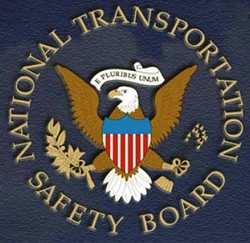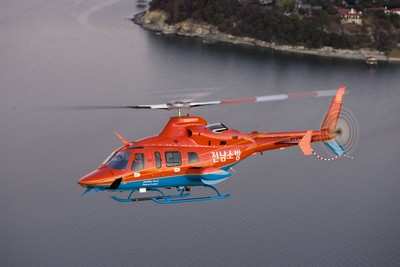Pilot Training, Night Vision, Improved Data Collection Among
The Issues Addressed
 ANN REALTIME UPDATE 09.01.09 1515
EDT: The NTSB Tuesday issued 19 recommendations regarding
Helicopter Emergency Medical Services (HEMS). These
recommendations address various safety issues including pilot
training; safety management systems to minimize risk; collection
and analysis of flight, weather, and safety data; flight data
monitoring; development of a low altitude airspace infrastructure;
and the use of dual pilots, aatopilots, and night vision imaging
systems (NVIS).
ANN REALTIME UPDATE 09.01.09 1515
EDT: The NTSB Tuesday issued 19 recommendations regarding
Helicopter Emergency Medical Services (HEMS). These
recommendations address various safety issues including pilot
training; safety management systems to minimize risk; collection
and analysis of flight, weather, and safety data; flight data
monitoring; development of a low altitude airspace infrastructure;
and the use of dual pilots, aatopilots, and night vision imaging
systems (NVIS).
HEMS operations include an estimated 750 helicopters, 20
operators, and 60 hospital-based programs. They transport
seriously ill patients and donor organs 24 hours a day in a variety
of environmental conditions. "The pressure on HEMS operators
to conduct their flights quickly in all sorts of
environments makes these types of operations inherently more risky
than other types of commercial flight operations," said NTSB
Chairman Deborah A. P. Hersman. "Operators need to every
available safety tool to conduct these flights and to determine
when the risk of flying is just too great."
For the HEMS industry, 2008 was the deadliest year on record
with 12 accidents and 29 fatalities. In response to this
increase in fatal accidents, the NTSB placed the issue of HEMS
operations on its Most Wanted List of Transportation Safety
Improvements.
Last February, the NTSB conducted a 4-day public hearing to
critically examine the safety issues concerning this industry. The
hearing, which included testimony by expert witnesses representing
HEMS operators, associations, manufactures, and hospitals, explored
the increasingly competitive environment of the HEMS industry and
provided a more complete understanding of why this industry has
grown rapidly in recent years. As a result of recent accident
investigations and testimony presented at the hearing, the NTSB
made recommendations to the Federal Aviation Administration (FAA),
the Centers for Medicare & Medicaid Services (CMS) at the
Department of Health and Human Services, Federal Interagency
Committee on Emergency Medical Systems (FICEMS) and 40
government-operated or public HEMS operators.
The 19 recommendations issued today include 10 recommendations
to the FAA to address the issues of improved pilot training;
collection and analysis of flight, weather, and safety data; flight
data monitoring; development of low altitude airspace in
infrastructure; and the use of dual pilots, autopilots, and
NVIS.
The two safety recommendations to the CMS are to evaluate the
current HEMS reimbursement rate structure and its relationship to
patient transport safety. Two recommendations are to FICEMS
to address coordination and integration of helicopter emergency
medical transport into local and regional emergency medical systems
and selection of the most appropriate emergency transportation mode
for victims of trauma.
Finally, five recommendations are to public operators to improve
pilot training, flight data monitoring; and the use of dual pilots,
autopilots and NVIS.
Original Report
1230 EDT The NTSB is expected to release
recommendations for changes in equipment and procedures Tuesday in
an effort to improve safety for medical helicopter operations.
The Wall Street Journal reports that the recommendations will
likely include additional training for pilots of at least some
medical helicopters, as well as expanding the use of dedicated
airways and improved flight data collection. Weather
forecasting is also expected to be among the factor cited as
needing improvement in the report.
The Board is also expected to once again call for more use of
night vision goggles by medical helicopter pilots.
The flight data recording provision may prove particularly
problematic because of the rotary wing environment. The paper
reports The Flight Safety Foundation announced Monday it would
partner with several manufacturers for testing of equipment that
could operate effectively on helicopters, and while flight data
recorders are offered as a factory option on some aircraft, but the
challenge is to make them rugged and inexpensive enough to
encourage wide adoption of the devices as retrofits.

Medical Helicopter File
Photo
Tuesday's expected announcement comes 7 months after the NTSB
highlighted the high fatality rate in medical helicopter accidents.
In 2008, 12 fatal accidents were responsible for 29 deaths.
 Aero-News: Quote of the Day (04.28.25)
Aero-News: Quote of the Day (04.28.25) ANN's Daily Aero-Term (04.28.25): Decision Altitude (DA)
ANN's Daily Aero-Term (04.28.25): Decision Altitude (DA) ANN's Daily Aero-Linx (04.28.25)
ANN's Daily Aero-Linx (04.28.25) Airborne-Flight Training 04.24.25: GA Refocused, Seminole/Epic, WestJet v TFWP
Airborne-Flight Training 04.24.25: GA Refocused, Seminole/Epic, WestJet v TFWP Aero-News: Quote of the Day (04.29.25)
Aero-News: Quote of the Day (04.29.25)




